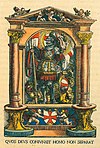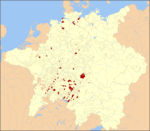Pfullendorf: Difference between revisions
new infobox |
OwenBlacker (talk | contribs) |
||
| Line 1: | Line 1: | ||
{{Infobox |
{{Infobox German Location |
||
|Art = Stadt |
|Art = Stadt |
||
|Wappen = Pfullendorf Wappen.png |
|Wappen = Pfullendorf Wappen.png |
||
|lat_deg = 47 |lat_min = 55 |lat_sec = 27 |
|lat_deg = 47 |lat_min = 55 |lat_sec = 27 |
||
|lon_deg = |
|lon_deg = 9 |lon_min = 15 |lon_sec = 24 |
||
|Lageplan = |
|Lageplan = |
||
|Bundesland = Baden-Württemberg |
|Bundesland = Baden-Württemberg |
||
| Line 16: | Line 16: | ||
|Kfz = SIG |
|Kfz = SIG |
||
|Gemeindeschlüssel = 08 4 37 088 |
|Gemeindeschlüssel = 08 4 37 088 |
||
|Adresse = Am Kirchplatz 1<br |
|Adresse = Am Kirchplatz 1<br>88630 Pfullendorf |
||
|Website = [http://www.pfullendorf.de/ www.pfullendorf.de] |
|Website = [http://www.pfullendorf.de/ www.pfullendorf.de] |
||
|Bürgermeister = Thomas Kugler |
|Bürgermeister = Thomas Kugler |
||
| Line 28: | Line 28: | ||
==History== |
==History== |
||
Pfullendorf was founded by the [[Alamanni]] tribe and named ''Dorf am Phoul'' (''Pfuol''), meaning ''village on the Phoul''. It was made a |
Pfullendorf was founded by the [[Alamanni]] tribe and named ''Dorf am Phoul'' (''Pfuol''), meaning ''village on the Phoul''. It was made a [[Free Imperial City]] in the [[Holy Roman Empire]] on [[June 2]], [[1220]] by [[Frederick II, Holy Roman Emperor]]. |
||
Starting in 1383, Pfullendorf governed itself with a democratic guild constitution, with annual election of the mayor. With brief interruptions, this guild constitution remained in force until 1803 and was a model for other cities. |
Starting in 1383, Pfullendorf governed itself with a democratic guild constitution, with annual election of the mayor. With brief interruptions, this guild constitution remained in force until 1803 and was a model for other cities. |
||
| Line 34: | Line 34: | ||
At the Council of Constance in 1415, King Sigismund gave the city the right of ''higher judgment'', that is, the right of execution. This meant that Pfullendorf was answerable only to God and the Emperor. |
At the Council of Constance in 1415, King Sigismund gave the city the right of ''higher judgment'', that is, the right of execution. This meant that Pfullendorf was answerable only to God and the Emperor. |
||
Although the [[Reformation]], the [[Peasants' War]], the [[ |
Although the [[Reformation]], the [[Peasants' War]], the [[Thirty Years' War]], the [[French Revolution]], and the [[Black Death|plague]] left their marks on the region, Pfullendorf was able to avoid major destruction. |
||
In 1803, Pfullendorf became part of [[Baden]], and it remained an administrative center in the upper Linzgau until 1936. It then became part of the district of [[Überlingen]], and belongs to the district of [[Sigmaringen]] since 1973. |
In 1803, Pfullendorf became part of [[Baden]], and it remained an administrative center in the upper Linzgau until 1936. It then became part of the district of [[Überlingen]], and belongs to the district of [[Sigmaringen]] since 1973. |
||
| Line 43: | Line 43: | ||
The [[German Army|German Army's]] Special Operations Training Centre (''Ausbildungszentrum für spezielle Operationen'') is located in Pfullendorf, as was the [[NATO]] International [[Long Range Reconnaissance Patrol]] School following its move from [[Weingarten (Baden)|Weingarten]] to its closure in 1999. |
The [[German Army|German Army's]] Special Operations Training Centre (''Ausbildungszentrum für spezielle Operationen'') is located in Pfullendorf, as was the [[NATO]] International [[Long Range Reconnaissance Patrol]] School following its move from [[Weingarten (Baden)|Weingarten]] to its closure in 1999. |
||
The town is [[town twinning|twinned]] with [[Allschwil]] in Switzerland since April 13, 1984 and with Saint-Jean |
The town is [[town twinning|twinned]] with [[Allschwil]] in [[Switzerland]] since [[April 13]], [[1984]] and with [[Saint-Jean-de-Braye]] in [[France]] since [[May 1]], [[1987]]. |
||
== External link == |
== External link == |
||
{{Commonscat}} |
{{Commonscat}} |
||
* [http://www.pfullendorf.de/ Official |
* [http://www.pfullendorf.de/ Official website] |
||
| ⚫ | |||
| ⚫ | |||
{{Sigmaringen-geo-stub}} |
{{Sigmaringen-geo-stub}} |
||
{{Swabian League}} |
|||
{{Circlesw}} |
|||
{{Free Imperial Cities}} |
|||
| ⚫ | |||
| ⚫ | |||
[[de:Pfullendorf]] |
[[de:Pfullendorf]] |
||
Revision as of 23:18, 14 November 2007
Pfullendorf | |
|---|---|
| Country | Germany |
| State | Baden-Württemberg |
| Admin. region | Tübingen |
| District | Sigmaringen |
| Government | |
| • Mayor | Thomas Kugler |
| Area | |
| • Total | 90.56 km2 (34.97 sq mi) |
| Elevation | 654 m (2,146 ft) |
| Population (2022-12-31)[1] | |
| • Total | 13,616 |
| • Density | 150/km2 (390/sq mi) |
| Time zone | UTC+01:00 (CET) |
| • Summer (DST) | UTC+02:00 (CEST) |
| Postal codes | 88630 |
| Dialling codes | 07552 |
| Vehicle registration | SIG |
| Website | www.pfullendorf.de |
Pfullendorf is a small historic city in the district of Sigmaringen in Baden-Württemberg in Germany.
Geography
Its location is in the district of Sigmaringen, 25 km north of Lake Constance and south of the Danube valley. The area is known as the Linzgau.
The surrounding towns are Wald, Herdwangen-Schönach, Meßkirch, Ostrach, Illmensee, Krauchenwies, Heiligenberg, and Deggenhausertal.
History
Pfullendorf was founded by the Alamanni tribe and named Dorf am Phoul (Pfuol), meaning village on the Phoul. It was made a Free Imperial City in the Holy Roman Empire on June 2, 1220 by Frederick II, Holy Roman Emperor.
Starting in 1383, Pfullendorf governed itself with a democratic guild constitution, with annual election of the mayor. With brief interruptions, this guild constitution remained in force until 1803 and was a model for other cities.
At the Council of Constance in 1415, King Sigismund gave the city the right of higher judgment, that is, the right of execution. This meant that Pfullendorf was answerable only to God and the Emperor.
Although the Reformation, the Peasants' War, the Thirty Years' War, the French Revolution, and the plague left their marks on the region, Pfullendorf was able to avoid major destruction.
In 1803, Pfullendorf became part of Baden, and it remained an administrative center in the upper Linzgau until 1936. It then became part of the district of Überlingen, and belongs to the district of Sigmaringen since 1973.
From 1972 to 1976, the neighboring villages of Aach-Linz, Denkingen, Gaisweiler, Tautenbronn, Großstadelhofen, Mottschieß, Otterswang, and Zell-Schwäblishausen became part of Pfullendorf.
Culture
The German Army's Special Operations Training Centre (Ausbildungszentrum für spezielle Operationen) is located in Pfullendorf, as was the NATO International Long Range Reconnaissance Patrol School following its move from Weingarten to its closure in 1999.
The town is twinned with Allschwil in Switzerland since April 13, 1984 and with Saint-Jean-de-Braye in France since May 1, 1987.
External link
- ^ "Bevölkerung nach Nationalität und Geschlecht am 31. Dezember 2022" [Population by nationality and sex as of December 31, 2022] (CSV) (in German). Statistisches Landesamt Baden-Württemberg. June 2023.




